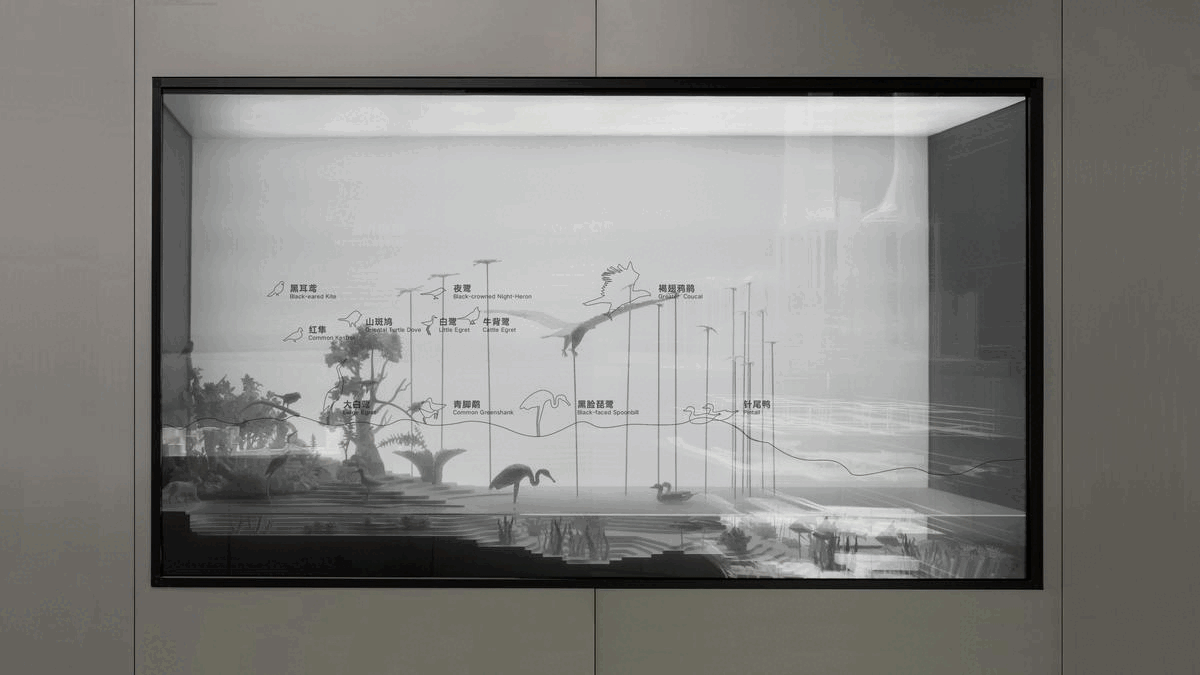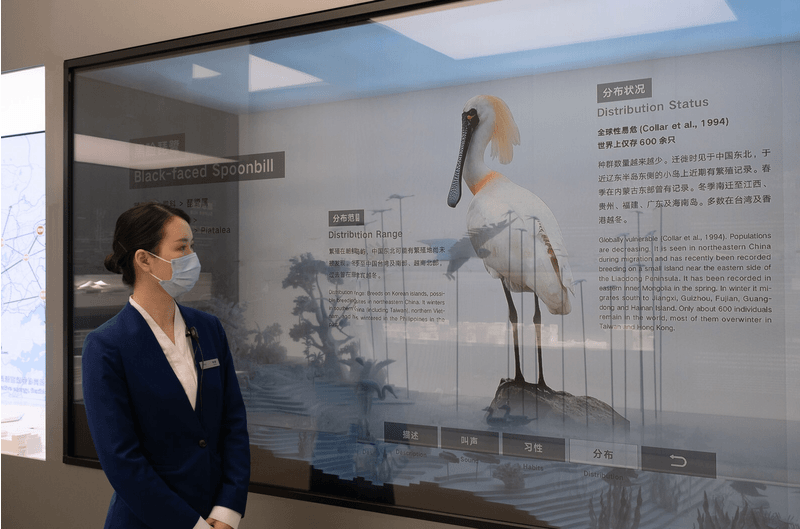Shenzhen Bay Super Headquarters Base City Showroom Design
Project Background Shenzhen Bay Super Headquarters Base is located in the center of Shenzhen's east-west development vein and the north-south mountain and sea corridor. It is endowed with a superior location and unique natural scenery. The total development area of the Shenzhen Bay Super Headquarters Base is 117 hectares, and the total development building area is about 5.2 million square meters. Shenzhen Bay Super Headquarters Base is committed to becoming an exemplary future city that combines a global headquarters cluster, a metropolitan cultural highland, an international communication center, and a world coastal living room. By systematically designing the layout, density, program, landscape, skyline, public space, underground space, architectural style integrated transportation, and smart city, we aim to build Shenzhen Bay as an intensive, efficient, ecological, and humane “City of the Future.” To further demonstrate the philosophy and dynamics of Shenzhen's development as a pioneering city, PILLS Studio was invited by Shenzhen Vanke to optimize and design the showroom of Shenzhen Bay Super Headquarters Base. The two exhibition halls are separated in volume and are linked by the building's service ribbon on the east side. The northern showroom shows the vision and achievements of the super headquarters planning and design, while the southern showroom shows Vanke's footprint as a witness of urban construction. Most of the existing city showrooms adopt specialized and conventional exhibition approaches, and few of them can vividly present the complex urban design concept to the viewers. In response to the difficulties of this design task, we take the following issues as the starting point of the design: first, how to display and articulate the philosophy and values of urban design in a more contemporary way; second, how to present the design core of Super Headquarters Base in a more vivid way; third, how to stimulate interest, curiosity and create an atmosphere in the limited space of the exhibition space. Most of the existing city showrooms adopt specialized and conventional exhibition approaches, and few of them can vividly present the complex urban design concept to the viewers. In response to the difficulties of this design task, we take the following issues as the starting point of the design: first, how to display and articulate the philosophy and values of urban design in a more contemporary way; second, how to present the design core of Super Headquarters Base in a more vivid way; third, how to stimulate interest, curiosity and create an atmosphere in the limited space of the exhibition space. Project Overview The concept comes from the Museum's predecessor, the Cabinet of Curiosity: between the 15th and 18th centuries, European collectors used rooms, chambers, and cabinets to display their collections of rare objects and precious artifacts. The objects are organized and juxtaposed in a space that preserves the inextricable ties between the categories. Each object is a material fragment from the natural sciences and human history, allowing the viewer to explore the history through the object. By connecting the viewer with the future through material fragments, the contemporary “Cabinet of Curiosities” is a metaphor for the city showroom of Shenzhen Bay Super Headquarters Base. Within this spatial framework, the project is organized around the logic of “Object” display. Based on tangibility, the design gives forms to urban visions and values and sets a dynamic scene to show the city's development. In a limited space, the showroom creates the medium for the viewer to connect with the macro urban narrative, wander and imagine the becoming city, and participate in the future. The narrative of the program creates a dialogue between the exhibition and the audience. The progressive and coherent flow links the diverse conceptual nodes that deconstruct the overarching vision. The exhibition content is integrated with the spatial form: the narrative structure corresponds to the circulation; the walls, niches, cabinets, and tables are combined to form a continuous yet diverse interactive interface; the nodes use different media to present the key design concepts. The combination of interactive models and multimedia installations creates an immersive experience with multi-sensory participation, making the city visible and tangible, and allowing people to interact with the environment and the future. The showroom generates and organizes the exhibition logic by deconstructing the design concepts of Super Headquarters Base, which are translated into eight montages of different scales. In the space, the systems and nodes of the Super Headquarters are displayed in layers and are threaded by circulation. Display cases, tables, and niches are combined to display various models and multimedia contents, overlaying the material level of information and the Spatio-temporal dimension of the exhibition narrative. The preface of the small hall demonstrates the strategic role of the Shenzhen Bay Super Headquarters Base in the integration process and urban planning structure of the Greater Bay Area, laying the background for the overall narrative. The plan of the Shenzhen Bay area shows the important city nodes along the route, reflecting the advantages of “Super Location" transportation resources and the great potential of linking the Guangdong-Hong Kong-Macao Great Bay Area. The planning concept of Super Headquarters Base - “One Center, Two Cores, the Ecological Cross" is demonstrated by a plan diagram to emphasize the “Supercross" structure of the scheme, explaining the layout for integrating landmarks of regional height, culture, and park. The node is designed to build a macroscopic and general framework for the narrative. Renderings and multimedia of the design scheme complement the demonstration of the urban planning concept. The “Super Bay Center" is located at the center of the cross structure of the Shenzhen Bay Super Headquarters Base, and consists of three skyscrapers, integrated surrounding transportation hubs, and cultural facilities. We deconstructed the core area's complex three-dimensional system in the form of an exploded model, presenting the underground space and facilities system, the above-ground road system, and architectural landmarks in a clear and detailed manner to the audience. It explains the concept of urban construction and the possibility of shifting from the “Crowded Genre” of the metropolis to the integration of people, city, and nature. The innovative model fully reflects the nature of Shenzhen Bay Super Headquarters as a new metropolitan model, a landmark of vitality, prosperity, and ecological coexistence. The T-shaped counter on the other side of the exhibition hall contains a model of the Central Green Axis and a three-dimensional display of the “Five Habitats.” The Central Green Axis is the north-south urban green valley of Super Headquarters, connecting the bay and wetland, showing the beauty of symbiosis between humans and nature. The central green axis model unveils the above-ground ecological design and the underground transportation system by lifting the roof. Combined with the program animation, the model intuitively shows the “Super Campus" design concept and its relationship with the surrounding land. Next to it, the ecological model sample is combined with a transparent touch screen to vividly demonstrate the diverse ecosystem of Shenzhen, emphasizing the original design intention of harmonizing the human and nature of the Super Campus, and the design concept of high-density settlement and sustainable development. The interactive ecological box renders the model readable, and by touching it, more information about the vegetation and birds inhabiting the area can be pulled out, stimulating the viewer's curiosity and allowing for an emotional connection with the ecological environment. The “Future City Ridge” is one of the supercross axes, creating a low-density urban axis, a diversely interactive platform, and a vibrant low-density neighborhood for the breeding of unicorn companies as well as high-energy growth companies. The niche embeds the vision of urban space into the exhibition wall, demonstrating the future super-vibrant city and the place where 300,000 employed people will have their daily interactions, consumption, culture, and leisure activities. The section model of the neighborhood provides an intuitive understanding of the scale and mode of the future neighborhood in Super Headquarters. Shenzhen Bay Super Headquarters Base creates a railway-led three-dimensional transportation system, forming a Super Hub that connects 6-Rails and 6-Stations. Employing a section mode, the “Super Hub” showcases the integration of existing Metro Lines 2, 9, and 11, with the planning Metro Line 29, and the 6-Rails 6-Stations that allow for the Shenzhen-Dongguan intercity, and Guangzhou-Dongguan-Shenzhen intercity transportation. The service scope and capacity of the “Super Hub" cover the Guangdong-Hong Kong-Macao Greater Bay Area. The future Super Headquarters Base is a gathering place for Shenzhen's landmark buildings. Twenty-one completed skyscrapers are incorporated into the exhibition niche to show the extraordinary strength of the “Super Users” who will reside in the Super Headquarters. The “Headquarters Towers” showcase uses replaceable light boxes to display the landmark buildings. The empty spots are reserved for continuously joining future users. It demonstrates the constant vitality and potential contained in the Shenzhen Bay Super Headquarters as a growing bay area. The screen shows the group portraits of the global headquarters of the world's leading 500 enterprises like the China Merchants Bank, ZTE, Vanke, and OPPO. The audience can understand the core ideas of the urban design of Super Headquarters in detail through different panels that meticulously parse out the design scheme. Exiting the narrative of the small hall is where the sand table of the Super Headquarters Base is presented. The viewer can shift from the knowledge of the local part of the design to the overall perception of the city area. Section models of the city are set up on either side of the hall, combined with a sliding touch screen to form an information slice of the city. The combination of the physical and the corresponding sectional information enables the viewer to further understand the key areas through interaction. The showcase reorganizes the disassembled information into a whole, presenting the total image of the future headquarters. The 1:500 sand table model in the hall's center demonstrates the overall image of Super Headquarters Base and its regional relationship with Shenzhen. The inclined main screen and the existing strip screen surrounding the sand table show the design concept and bright future of Super Headquarters Base. The main and the auxiliary screens cooperate, combined with the sand table model, to show multiple information. The multimedia content responds to different display scenarios and crowd needs by switching through chapters, creating an immersive viewing experience. Project Summary Through the cutting-edge visual language, immersive presentation, and interactive spatial experience, the design gives form to the philosophy of the Super Headquarters Base. Sound and moving images are unobtrusively integrated into the scenes, complementing the exhibits and their historical context, while at the same time shifting from the conventionally prescribed narrative to creating a sense of mise-en-scène and drama. The exhibition not only helps viewers from different backgrounds to participate more actively in the narrative through an immersive montage spatial experience, but also continues Pills’exploration of multi-perspective narrative, establishing the connection between space, objects, and text, and endowing a single space with multiple narrative possibilities and reading depth. The exhibition depicts the blueprint of the Super Headquarters Base as the urban gateway in the process of constructing the Greater Bay Area, showing the achievements of the city's construction. Through a design of international vision, forward-thinking, and innovation, the showroom meets the high level of planning and construction standards of the Super Headquarters Base. Together, we will witness Shenzhen, a metropolis full of opportunities and vitality, become an influential global benchmark city shortly in the future.
Project Information Project Type: Exhibition Design Project Location: Nanshan District, Shenzhen Design area: 750 m² Client: Shenzhen Vanke Development Co. Client's Team: Lin Qi, Linlin Pan, Eddie Han, Lihydro Zhang, Shan Liu, Xiexin Zhang, Chuan Wang, Yuxiang Zhong, Hao Zhang Instructing Unit: Shenzhen Bay Super Headquarters Base Development and Construction Command Office Design time: 2020-2021 Showroom Renovation and Exhibition Design: PILLS Chief Architect: Zigeng Wang Design Team: Ying Zhou, Jie Chu, Shaomin Zhang, Jianli Shi, Manying Wang, Canqi Mu, Shiman Xu, Xingzhu Jiang, Xiaohuan Zhang Consultants: Xin Jin, Zhiwen Ou, Xiaolin Ji Acknowledgments: Xiaodu Liu, Weiguo Zong Construction and Digital Content, Multimedia Technology team: Silu Visual Technology Co, Ltd


















